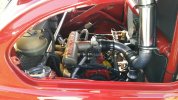Dr.Jeff
True Classic
I believe it was somewhere in this thread we discussed "detonation" and ECU tuning? So I'll add this here.
The key to tuning for maximum performance without detonation (pre-ignition, knock, etc) is knowing what's going on inside the combustion chamber as combustion exists. The following presentation should be helpful with that:
 www.sema.org
www.sema.org
Honestly I'm not sure if you need to be a member of SEMA to join the presentation.
The key to tuning for maximum performance without detonation (pre-ignition, knock, etc) is knowing what's going on inside the combustion chamber as combustion exists. The following presentation should be helpful with that:
How to Improve Engine Performance by Optimizing Cylinder Pressure
R&D engineer Gary Patterson at Roush Yates Engines will cover cylinder pressure measurement tools, identifying data in real-time, and actions to take as a result of the data.
Honestly I'm not sure if you need to be a member of SEMA to join the presentation.
Last edited:



